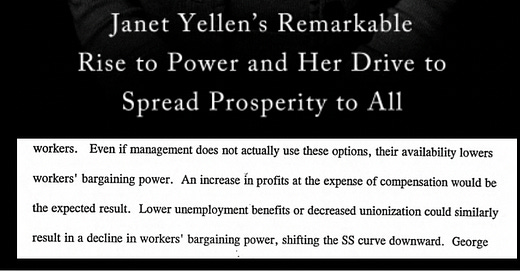Empathy Economics and Social Classes
A primary source on Janet Yellen and the conflict theory of inflation
Around the New Year, the leading mainstream macroeconomist Olivier Blanchard started an interesting debate around the role of social conflict in explanations of recent inflation. Among some heterodox economists, Blanchard’s frank recognition “that inflation is fundamentally the outcome of the distributional conflict” was an encouraging sign that post-Keynesians and other radicals have been right all along.1 Others objected that Blanchard’s intervention is somewhat perverse: whatever intellectual validation the left may enjoy from the mainstream embrace of conflict inflation is more than offset by Blanchard’s (and Krugman’s) misleading invocation of a wage-price spiral for which there is little evidence at the moment. If mainstream economists discover worker power only in order to urge a needless attack on worker power, what has really been gained?
I hope to write more about the complicated politics of this ideological “convergence on conflict” soon. This post, however, is just to share a relevant primary source I recently received from the Federal Reserve via Freedom of Information Act request. Through this FOIA request, I obtained (I believe for the first time) a memo sent by Janet Yellen for Alan Greenspan on June 10, 1996, regarding “Job Insecurity, the Natural Rate of Unemployment, and the Phillips Curve.” You can download the document to read here:
The existence of this memo is referenced in Maestro, Bob Woodward’s love letter to Alan Greenspan, as well as Owen Ullman’s extravagantly titled Empathy Economics: Janet Yellen’s Remarkable Rise to Power and Her Drive to Spread Prosperity to All. The basic thrust of the memo is not surprising, given Greenspan’s notorious public comments about the salutary effects of worker trauma on price stability, as well as Yellen’s own embrace of this perspective in publicly available FOMC minutes. The memo confirms that, whether we deify our central bankers as masculine-Olympian maestros or RBG-style empaths, the Federal Reserve is consistent in its view that low interest rates (and by extension, economic expansion and lower unemployment) is contingent on the radical post-1970s “decline in workers bargaining power” (a phrase taken directly from Yellen’s memo). The “declining worker power” in which Larry Summers conveniently took a brief interest just before the 2020 election was a premise of the 1990s boom, which the best minds of Democratic Party economics still remember as the best American capitalism has to offer.
In the post linked here, Lavoie and point out that Blanchard’s interest in the wage-price spiral dates back to this publications from the 1980s. Along the same lines, it is worth noting that in 1980 Yellen published an AER article that focused on the same sort of spiral: “In the Post-Keynesian model, higher money wage demands necessarily lead to higher prices without raising the real wage and so there is nothing to stop inflation once it begins…Post-Keynesians conclude from their analysis of inflation that the solution lies in incomes policy. What is needed is societal agreement concerning the appropriate distribution of income.” Yellen concluded at the time that “the Post-Keynesian gap here between theory and policy is quite large.” By the end of the decade the practical problem had been solved by Volcker and Reagan, who, as Hyman Minsky pointed out already in 1988, “had an incomes policy” of their own: “it accepted a long period of high unemployment rates, it welcomed imports, it kept the minimum wage constant, and it bashed unions.”
[UPDATE: Yellen also published in 1984 on "Efficiency Wage Models of Unemployment," including the Shapiro-Stiglitz model which figures prominently in the memo to the Greenspan. According to her acknowledgments, Yellen received comments on the paper from Michael Reich, a founder of the New Left-era Union for Radical Political Economics.]




Thing is, measures this writer envisions to increase worker power would benefit just the workers at the very top of the hourly labor force. They have the most visibility on Capitol Hill, are more likely to be enrolled in a declining number of labor unions, and are well enough organized to take advantage of these opportunities.
Meanwhile the face of American labor looks less and less like anything in the Saul Alinsky playbook. It's freelance, temporary, as-needed, and most of all has none of the social and political institutions workers used to rely on -- not just for help, but for identity, and connection with other workers. The checker at the all-night minimart doesn't even think of herself as a 'worker' -- she's simply a mom trying to get by.
Tim, the classic Marxian knock on "bourgeois economics" has been that doesn't comprehend the class relations underpinning capitalism, but it seems like now they are just openly being like "Yeah, capitalists just need to beat the hell out of workers." Do you think this is a new development?